

All About Manatees
Lovable, Gentle Water Creatures
Manatees are large mammals that live their entire lives
in the water. They are very gentle creatures that have no natural predators.
Manatees live in warm shallow waters and they eat only plants making them
herbivores.
A typical 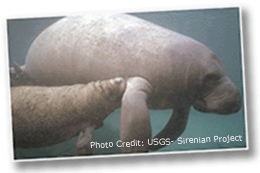 manatee
is able to live for 50-60 years.
manatee
is able to live for 50-60 years.
Manatees and dugongs are members of the order Sirenia. Sirenia includes
4 living species: the West Indian manatee, the West African manatee, the
Amazonian manatee, and the dugong. The West Indian manatee has two subspecies,
the Florida and Antillean manatees. They are all listed as vulnerable to
extinction
on the IUCN's (International Union for Conservation of Nature and Natural
Resources) red list. The order once included a fifth modern species, the
Steller’s sea cow. Unfortunately, the Steller's sea cow is now extinct
due to over hunting.
It is thought that Sirenians evolved
from four-footed land mammals about 45-50 million years ago. Modern relatives
of Sirenians are elephants, aardvarks, and hyraxes—small rodent-like
mammals.
West Indian manatees live in the warm coastal waters of the southern United
States, Mexico, the Caribbean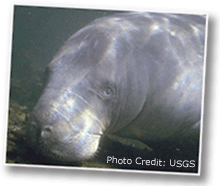 Islands, Central America, and the northeastern countries of South America.
They are found in rivers, lagoons, estuaries,
and coastal areas of tropical and subtropical regions of the northwest Atlantic
Ocean from southeastern USA to Brazil. They can live in both salt and fresh
water.
Islands, Central America, and the northeastern countries of South America.
They are found in rivers, lagoons, estuaries,
and coastal areas of tropical and subtropical regions of the northwest Atlantic
Ocean from southeastern USA to Brazil. They can live in both salt and fresh
water.
Like most manatees, West Indian manatees prefer shallow water that is 2
to 6 meters (or 6 to 18 feet) deep and are rarely found in water deeper
then twenty feet. Because they have a very slow metabolism,
they can only survive in warm waters. In the United States, the Florida
subspecies migrates
to warm water places when the water temperature dips below 20 degrees Celsius
(67 degrees Fahrenheit) - about room temperature.
However, in Central America, where the water temperature is warm all year,
manatees don't need to migrate in response to temperature. The movements
of the Antillean subspecies are more likely tied to changes in the rainy/dry
season or perhaps due to mating behavior. Researchers like Katie, Caryn
and other scientists in Belize are trying to learn more about the Antillean
manatee's movements.
Mermaids and Sea Cows
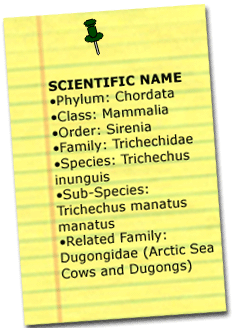 Manatees have been called many names including sirenians, sea cows and even
mermaids. The first Europeans to encounter manatees thought that they were
seeing the mythically beautiful mermaids-half woman, half fish creatures.
On closer inspection however, they were disappointed to see that these animals
were not quite as beautiful as they thought.
Manatees have been called many names including sirenians, sea cows and even
mermaids. The first Europeans to encounter manatees thought that they were
seeing the mythically beautiful mermaids-half woman, half fish creatures.
On closer inspection however, they were disappointed to see that these animals
were not quite as beautiful as they thought.
"Sea cow" is another common term used for both manatees and dugongs.
This name likely comes from the fact that manatees are herbivores and spend
most of the day grazing on seagrasses like cows that spend most of their
day grazing on grass and hay.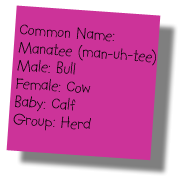
Trichechus manatus manatus
The scientific name for the Antillean manatee is Trichechus manatus
manatus. Sounds funny but scientists use complex schemes (scientific
names) for naming plants and animals in order to categorize and discuss
the natural world. The rest of us use common names for plants and animals,
like manatee or seacow.
The scientific genus name "trichechus" is Latin for hair and refers to the small hairs that are found all over the manatee's body. The name Sirenian comes from a word in ancient mythology known as "siren". Sirens were half woman-half bird creatures known to lure sailors to dangerous parts of the sea and their deaths. In Homer's Odyssey sirens were mythical women who lured the men into a dangerous whirlpool.
Appearance
Manatees range in color from gray to brown with wrinkled skin and single
bristle-like hairs scattered all over their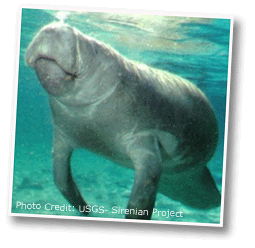 bodies. Thick whiskers cover their snouts. Manatees have a paddle-shaped
tail that they use to get around and propel their bodies through the water.
They also have two flippers in the front of their bodies that they use for
guiding their bodies and scooping up their food. Some manatees have three
or four nails on the tip of each flipper. The nostrils are located on the
topside of the snout and can be closed tightly by valves when the manatee
is underwater. Their eyes have inner membranes that can cover the eyeballs
for additional protection.
bodies. Thick whiskers cover their snouts. Manatees have a paddle-shaped
tail that they use to get around and propel their bodies through the water.
They also have two flippers in the front of their bodies that they use for
guiding their bodies and scooping up their food. Some manatees have three
or four nails on the tip of each flipper. The nostrils are located on the
topside of the snout and can be closed tightly by valves when the manatee
is underwater. Their eyes have inner membranes that can cover the eyeballs
for additional protection.
An adult manatee is typically nine to ten feet long and weighs about 1,000
pounds, although they can grow as large as thirteen feet and weigh more
than 3,000 pounds. Adult females are generally larger than adult males.
Communication
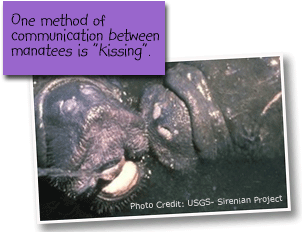 Manatees use various forms of communication in the water such as sound,
sight, taste and touch. Manatees have an acute ability to hear and squeals
are often used to keep contact between a mother and calf. It is thought
that manatees are able to hear sounds that are even too low for humans to
detect. However, vision seems to be the preferred method of navigation.
Sometimes though, they are unable to see through some of the murky waters
of their habitat.
Manatees use various forms of communication in the water such as sound,
sight, taste and touch. Manatees have an acute ability to hear and squeals
are often used to keep contact between a mother and calf. It is thought
that manatees are able to hear sounds that are even too low for humans to
detect. However, vision seems to be the preferred method of navigation.
Sometimes though, they are unable to see through some of the murky waters
of their habitat.
Individuals rub themselves against hard surfaces which may be a way that
they clean themselves, but this behavior may also be a way that manatees
leave their scent so other manatees can find them.
Reproduction
Most female manatees are able to breed
successfully by the age of six. Typically, gestation
periods for West Indian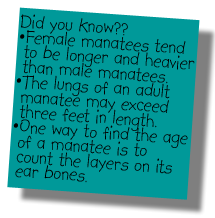 manatees range from twelve to fourteen months. Females tend to produce one
calf with each pregnancy, although they sometimes have twins. The normal
interval between births is two to five years and new calves are typically
dependent on their mothers for about two years.
manatees range from twelve to fourteen months. Females tend to produce one
calf with each pregnancy, although they sometimes have twins. The normal
interval between births is two to five years and new calves are typically
dependent on their mothers for about two years.
Food Source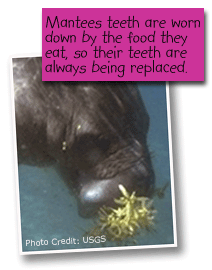
Manatees spend six to eight hours each day eating. Typically they eat four
to nine percent of their body weight in food. Manatees are herbivores and
have been known to eat over sixty species of plants with the most common
being seagrass. They have a flexible upper lip that they use to bring food
into their mouth. They do this by grabbing and tearing the plant with their
lips. The snout of West Indian manatee is bent further down than other species
in this family and enables them to feed mainly on seagrasses growing on
the sea floor. Because sand is commonly mixed with the plants their teeth
are easily ground down so their teeth are continuously being replaced. Manatees
mostly eat in the water but they use high tides to reach feeding grounds
and shoreline vegetation that are inaccessible at low tides. Amazingly,
they are able to crawl parkway onto a bank to reach shoreline vegetation.
An Average Day
An average manatee spends six to eight hours a day feeding, two to twelve
hours sleeping, and the rest of the time traveling. When resting, a manatee
is able to suspend itself near the surface of the water but it can also
lie on the bottom of the sea floor. 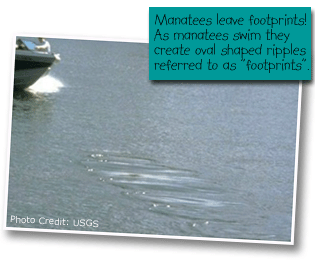
Water Ballet
A large resting manatee can stay submerged for about twenty minutes, but
others need to resurface every three to four minutes. By using both their
tail and flippers, manatees are capable of complex maneuvering including
somersaults, rolls, and swimming upside-down. A manatee typically swims
with up-and-down motions of its body and tail, like a whale or dolphin.
Although manatees typically swim at a speed of two to six miles per hour,
they have been known to be able to sprint at speeds of up to fifteen miles
per hour.
Status
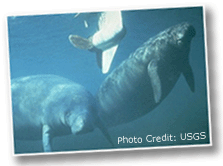 Historically,
manatees of Belize have been hunted for food, their hides, and their bones.
This hunting continues in many South and Central American countries. Yet
the leading cause of manatee death worldwide is due to collisions
Historically,
manatees of Belize have been hunted for food, their hides, and their bones.
This hunting continues in many South and Central American countries. Yet
the leading cause of manatee death worldwide is due to collisions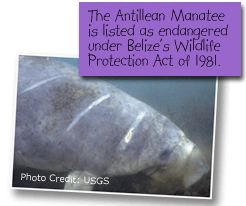 with boats or becoming tangled in fishing nets. Pollution, such as red tide
toxins, also strongly affects manatee populations.
with boats or becoming tangled in fishing nets. Pollution, such as red tide
toxins, also strongly affects manatee populations.
The West Indian manatee is listed in the Convention on International Trade
in Endangered Species (CITES). Manatees living in the Belizean coastal waters
are not as affected by human activity as they are in other locations such
as Florida. The high water craft traffic of the waters of Florida is one
of the leading causes of manatee death in there. One way researchers identify
individual manatees is by the scars on their bodies from propellers and
fishing gear. Although the manatees of Belize are not as affected by water
craft traffic now, it may become a danger as population and development
in Belize increases.